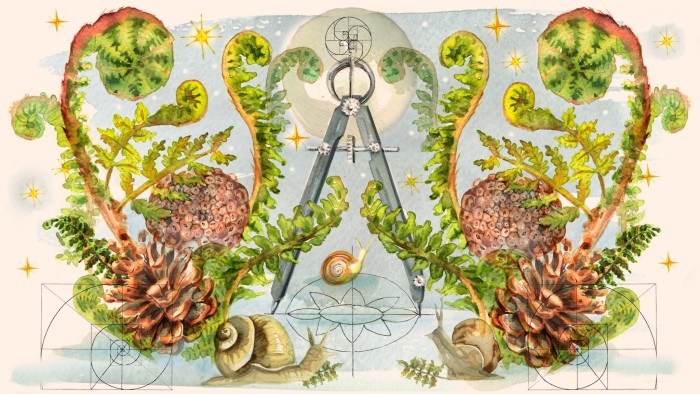Unlock the Editor’s Digest for free
Roula Khalaf, Editor of the FT, selects her favourite stories in this weekly newsletter.
The human world is distressingly chaotic. Nature, in contrast, always has a plan. This is on display in my garden, where ferns are now unfurling. Most are defined by repeated patterns. The spiral is the most striking.
It is heartening to see these emerging. These are harmonious fiddleheads. They are nothing like Kindleberger’s Spiral, an omen of economic atrophy lately brandished by market pundits.
The uncoiling fronds are an advance guard, heralding the botanical abundance of summer. The royal ferns, the tree fern, the polystichums — they are all at it. Each frond within the burgeoning crown starts as a coil. Within this lurk the smaller spirals of the leaflets that comprise the green blade of the frond. As the frond uncoils, so do the leaflets.

The frond loses its spirals. The galaxy where our planet is situated — the Milky Way — does not. This will continue spinning outwards for a few billion growing seasons to come.
I asked Edinburgh university plant scientist Dr Sandy Hetherington why natural spirals fascinate us. He quoted Charles Darwin: “From so simple a beginning, endless forms most beautiful and most wonderful . . . are evolved.” He added: “We enjoy trying to find order in nature. So these highly ordered patterns are deeply satisfying.”
Fully developed fronds embody another pattern. Each leaflet is a smaller version of the frond of which it is part. In the same way, the leaflet’s constituent serrations mirror its overall form. This phenomenon is called “self-similarity”. In maths, the term “fractal” would sometimes apply, meaning that the same shape repeats at diminishing scale.
And, no, I never got to the end of James Gleick’s fractal-driven 1987 maths bestseller Chaos either.
I owe my new interest in botanical geometry to the more accessible Do Plants Know Math?, published by Princeton University Press. This handsome book unpicks the splendour of plant forms.
Previously I had only pondered spirals in garden snails. This became a question of national importance in 2017, when media highlighted the lonely plight of Jeremy, a Nottingham University study mollusc. Jeremy’s rare left-handed spiral meant the location of his genitals precluded amorous activity with most other snails. A frantic search ensued for a sinistral soulmate.
Spirals are far commoner in plants than animals. Their most mind-bending aspect is their frequent correspondence with Fibonacci numbers. Here, each number is the sum of its two predecessors. The sequence starts like this: 0, 1, 1, 2, 3, 5, 8. Then it spirals out into infinity.

If you look at a sunflower centre or a pine cone, you will see that the florets or scales are arranged in left-hand and right-hand spirals. Count them, and you will generally find the totals in each category are adjacent Fibonacci numbers. So 34 and 55 for a sunflower. Or 8 and 13 for a pine cone.
Do Plants Know Math? urges readers to take smartphone snaps of appropriate plant parts and trace the spirals with a “draw” function to uncover the numbers. Thus may nature study hybridise with Sudoku.
I would avoid trying this with a Romanesco cauliflower, unless you have a lot of time on your hands. Its numerous spirals not only embody Fibonacci numbers. They do so at multiple fractal levels. Romanesco needs something to distinguish it, frankly. It is no great shakes as food, in my view. But I grew up in 1960s Aberdeen. So I only know how to boil things.
The twirly horticultural story really starts spinning when we get to helices. The tips of leaves sprouting along a straight stem often trace a helical pattern (not strictly a spiral, but an ally, perhaps). Leaves growing directly above one another a distance apart sometimes encode Fibonacci numbers.

“And there’s more!” as they holler on the shopping channels. Each successive leaf on the helix is apt to protrude at around 137.5 degrees. This is another talismanic number — one element of the “golden ratio” used by Greek maths genius Euclid to chop lines into self-similar segments.
Darwin found all of this a bit much. It bothered him that some perfectly satisfactory theoretical arrangements of leaves along stems did not exist in nature. “Those plants! Always with the Fibonacci numbers!” he exclaimed to a friend (I paraphrase).
A little mystery usefully reminds us how limited human knowledge remains. Stonehenge would, for example, be a lot less interesting if we knew with absolute certainty that it was the remains of a Neolithic amusement arcade erected using primitive backhoe diggers.
Scientists have a lot more to discover about plant geometry without much danger they will ever be able to answer the question “why?” with any certainty.
Researchers include the aptly named Dr Michael Sundue of Royal Botanic Garden Edinburgh, who says: “My origins story is that I wanted to learn everything there was to know about all the plants. I started with ferns and I still haven’t finished.” This intrepid plant hunter hacks through South American jungles braving guerrillas, venomous snakes and a complete absence of Michelin-starred restaurants. He returned from one trip to discover a fern species apparently new to science growing quietly in one of the glasshouses at his place of employment.
There are botanical wonders sprouting under all our noses, as unfurling garden ferns remind us.
“Do Plants Know Math?” by Stéphane Douady, Jacques Dumais, Christophe Golé and Nancy Pick, Princeton University Press
Find out about our latest stories first — follow @ft_houseandhome on Instagram
